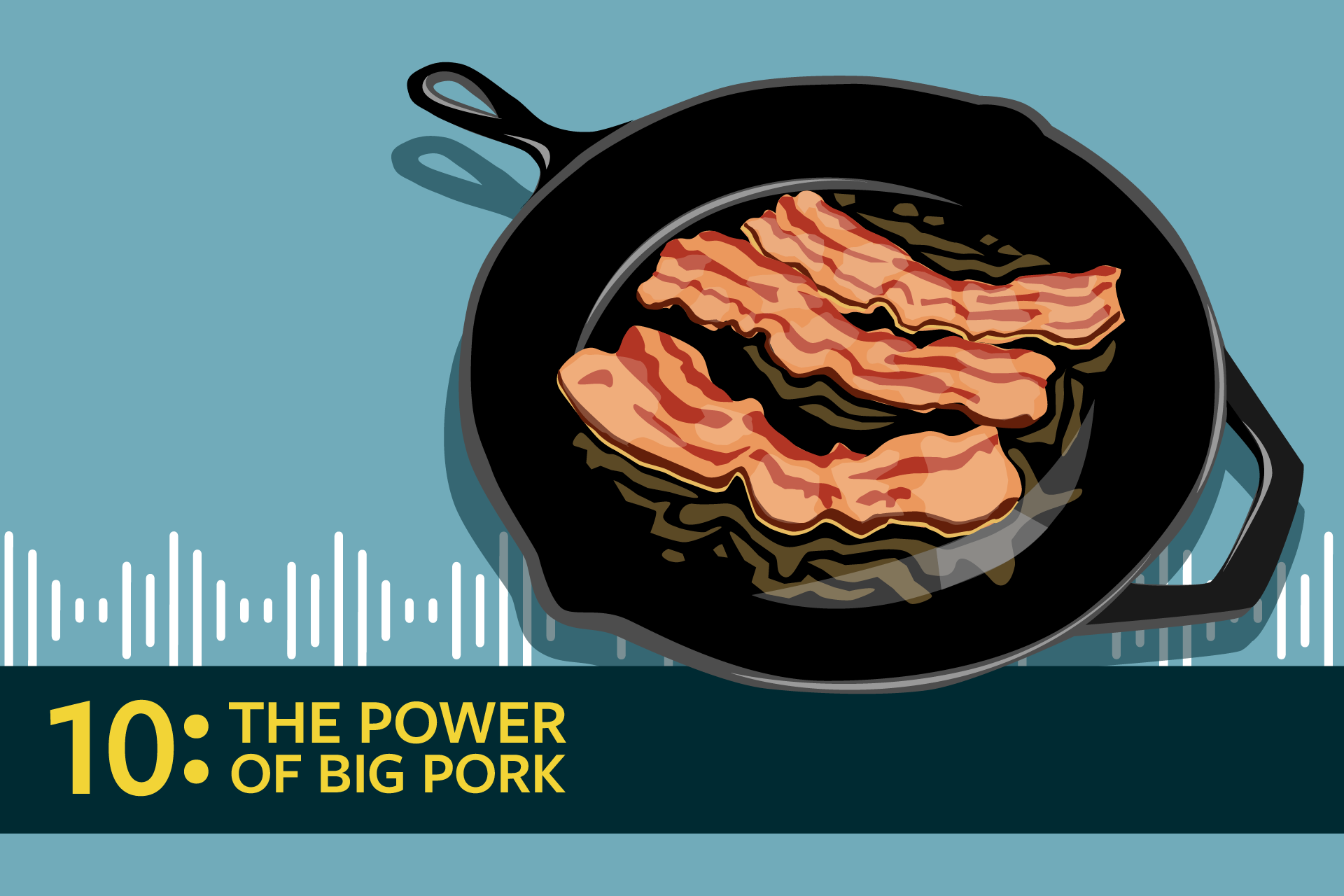Real Food Encyclopedia | Pork
Branded by the pork industry and its marketers as “the other white meat,” pork (pig meat) is an extremely versatile and beloved product. But the industrial pork industry contains some of the worst practices in food production, responsible for environmental degradation and animal cruelty. Read on to learn more about all things pork, including more sustainable and humane alternatives.
What to look for when buying pork
Pork quality varies widely depending on how it was raised. Here are some tips for enjoying meat from well-kept animals:
- Talk to your farmer: The single best way to ensure that the pigs are well-raised is to know the person that is raising them. Animal husbandry is complex and worthy of a chat. If you shop at your local farmers’ market, you can get the conversation going there.
- Trust a third party: A great sustainable butcher or regional sustainable meat supplier can be your personal guide to good eating. Unlike big box stores that are beholden to corporate contracts, independent shop or business owners can order directly from producers or producer cooperatives. If they don’t currently carry the kind of pork you want to see, talk to them about it.
- Look for the label: Look for pork that is pasture-raised, for starters. You may also want to seek out a humane certification like Animal Welfare Approved or Certified Humane. There are several certification programs that can point you in the right direction. Find out which labels are the best in the FoodPrint Food Label Guide.
Sustainability of pork
You can read more about the problems with factory farming in our deep-dive report on pork production, The FoodPrint of Pork, or in our podcast episode, The Power of Big Pork. On industrial farms where pigs are raised by the thousands, many environmental, animal welfare and labor problems arise. Concentrated animal feeding operations (CAFOs, also known as factory farms) are notorious for the negative environmental and community impacts.
The copious amount of waste produced by these overcrowded facilities is often held in pits or lagoons that pollute the air. These lagoons or pit and can leak, break or overflow with ruinous impact on local waterways.
Hog farming does not necessarily have a negative impact on the environment. A pasture-raised pig, raised as part of a farm’s ecosystem, plays a valuable role in that interconnected system, absorbing waste and providing fertilizer which can be used to increase the fertility of the farm.
Seasonality
Traditionally, hogs are butchered in the cooler months of the fall and early winter so that the meat can be hung for twenty-four hours after slaughter to allow it to drain and chill without freezing. The array of curing methods, described below, enabled the meat to be enjoyed throughout the year without refrigeration.
In industrial CAFOs, hogs are produced and slaughtered all year-round, but there is still a bit more activity in the last quarter of the year. Some operations may still have some seasonal breeding in place that accounts for the increased volume. Consumer demand also influences this slight increase as eaters feature hams on their holiday tables and cook more roasts in the winter than any other season.
At farmers’ markets, since most product is sold frozen, you should be able to find pasture-raised pork year-round.
Geography
In the United States, Iowa produces the most hogs in the union, with at least twenty million animals in production in the state at any one time. The U.S. is third in world production of pork. China is number one followed by the European Union.
Historians believe that modern pigs are descended from wild boars that were domesticated in China about ten thousand years ago. By 1500 BC, they were being raised in Europe. Pigs came to America with Columbus. But the establishment of significant domestic hog stocks is mostly attributed to Hernando de Soto, who brought thirteen pigs to Tampa Bay, Florida in 1539.
By the middle of the 1800s, the U.S. Midwest was becoming the center of the country’s national pig industry. Pigs were raised there and then driven, on the hoof, to be slaughtered at East Coast facilities, closer to the consumer. The advent of the refrigerated train car in 1887 consolidated the industry by finally allowing the slaughterhouses to move west as well, establishing the Midwest as the “Hog Belt,” a vertically integrated system that encompassed the entire process of production, slaughter, packaging and even feed production.
Post-World War II America entered a phase of agricultural automation. Meat animals became widgets to be raised quickly and efficiently with little attention paid to the well-being of the animal, farmer or eater.
As the industry has moved toward more efficiency and consolidation at all costs, a counter-culture has emerged of small, independent farmers dedicated to sustainable practices. While such farmers obviously want to remain economically viable, they also place value in the quality of the animals’ lives, the impact on the environment and the delicious flavor of the final product. Many of them are protecting biodiversity by raising heritage breed pigs that haven’t had their natural instincts and adaptability bred out of them. The Tamworth, Red Wattle and Gloucestershire Old Spots are just a few of the breeds that are being reintroduced on today’s farms.
Eating pork
Storing
Freshly cut pork keeps in the refrigerator for three to five days or can be frozen, tightly wrapped, for up to three months.
Cooking
Pork pairs with a wide range of flavors from smoky barbecue to tangy citrus, sweet stone fruits to spicy chilies. It can be roasted, braised, sautéed, ground and cured into a scrumptious array of dried sausages and hams. All parts of the animal can be used and enjoyed — the meat, offal and even the ears and tail.
Pork is a great candidate for flavoring dishes where meat is not the central player. So if you’re trying to reduce the amount of meat you eat, you can use a small ham hock for a giant pot of beans, or a few strips of bacon for a big pot of pasta. Pork’s flavor can really go a long way.
Preserving
Many cultures have traditions of preserving pork. Drying/salt curing, smoking, and wet-curing are three methods of preservation that can be used alone or in combination.
- Ham: Italian prosciutto, Spanish Jamon Serrano and Jamon Iberico are the hind legs that have been coated with salt and sometimes spices and air dried for months to years. What is often referred to as “country ham” here in the United States is also dried in this manner but is then also sometimes smoked for an additional layer of flavor. Wet-cured hams are submerged in liquid brine and refrigerated for several days to a couple of weeks to develop their flavor.
- Cured belly: Bacon, pancetta and cured Chinese bacon come from the belly of the animal and can be made in several ways. The bacon we typically eat, also called “streaky bacon” in the UK, is cold smoked. Pancetta is the same cut but is cured with herbs and spices and not smoked. Chinese bacon is treated with a rub of soy sauce and spices and then usually air-dried before being smoked.
- Sausages: Sausages give the butcher a chance to use up all the delicious scraps and bits that are too small for the pan but have wonderful flavor. They are mixed with spices and served fresh or dried and sometimes also smoked as well.
- Lardo: This Italian specialty is cured backfat.
- Confit or potted: This pork is made by simmering it in copious amounts of its own fat and then cooling it, completely submerged in the renderings.
Nutrition
Meat from animals raised on pasture have many nutritional benefits, including increased levels of omega-3 fatty acids, cancer fighting CLA (Conjugated Linoleic Acid) and Vitamin E.
Top photo by myviewpoint/Adobe Stock.


